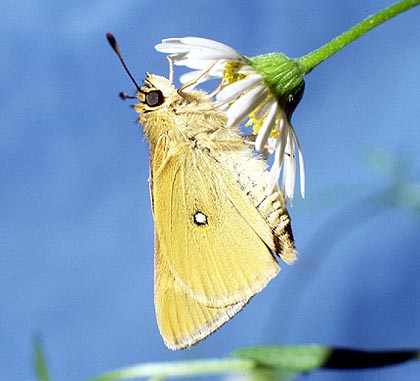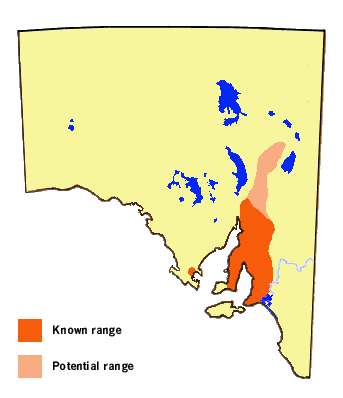Rare White-spot Rush-skipper
Trapezites luteus luteus (Tepper)
Interesting Aspects

A pretty skipper with colourful patterns on both wing surfaces.
Trapezites luteus luteus (Tepper)

A pretty skipper with colourful patterns on both wing surfaces.
Lomandra densiflora (soft-tussock mat-rush), L. filiformis, L. longifolia (spiny-headed mat-rush), L. multiflora ssp dura (hard mat-rush) (Asparagaceae). Lomandra filiformis and L. longifolia used as foodplants in the eastern states are not known to be utilised in South Australia. Larvae may also locally utilise other Lomanda species in South Australia as the butterfly has been historically recorded from areas in which none of the documented foodplants are known to occur. The larvae feed on the leaves.
Large, initially cream, later marked red if fertile, hemi-spherical (domal) with strong vertical ribs (18-25), laid singly on the foodplant. Eggs are usually laid on foodplant situated in full sun.
Brown with darker markings, short and fat, with minimal ornamentation about the head, abdomen bristly, and the cremaster is very long and spinose. Pupation takes place during spring or early summer, either in the final larval shelter or the larva may leave the foodplant and pupate in leaf or bark debris around the base of the foodplant.
Early October to early December. The flight starts earlier in the northern part of the distribution range, and finishes later in the southern part. Only one brood a year. An autumn brood may occur in the eastern states.

Presently confined to elevated areas in the northern Mt Lofty Range, Midnorth and southern Flinders Ranges where its foodplants occur, (the northern half of its known range). It has historically been recorded from the southern Eyre Peninsula, Yorke Peninsula, and the southern Mt Lofty Range, in which areas it is now believed extinct. Its foodplant is also locally common in the northern Flinders Ranges and therefore there is a good possibility the skipper will occur in that region. Interestingly, it has not been recorded from the Southeast Region. The local subspecies of the skipper is also found in western and central Victoria. Two other subspecies occur in Tasmania and in the eastern states as far north as southern Queensland, mostly along the Great Dividing Range.

Has been found where its foodplant occurs in sufficient density, which can occur in a variety of habitats. The skipper is most often seen in very open woodland and grassland containing its foodplant. Prefers its foodplant to be in full sun and uncongested by other plants. The males will hilltop and the presence of hilly areas may be a habitat pre-requisite.
Vulnerable. Recent surveys for the skipper suggest it is at the low end of the vulnerable scale, and provided some attempt is made to conserve or manage its habitat, the butterfly could be taken off the threatened list.
Much of the habitat is within the locust breeding belt and therefore subject to locust spraying. Some of the elevated areas along the Flinders Range are inhabited by feral goats, which have a particular liking for the Lomandra foodplant. In fact the Lomandra multiflora is highly susceptible to overgrazing by stock, feral and native animals.
Some grassland habitat bearing the Lomandra foodplant has recently been acquired for conservation purposes, but additional key areas may need to be conserved. The locust spraying needs to be done judiciously. The grazing of Lomandra bearing habitat should be carefully managed, and the feral goat populations need to be controlled. Consideration should be given to repopulation programs for the skipper, back into conservation areas within its known southern range.